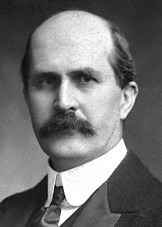William Henry Bragg

Sir William Henry Bragg OM, KBE, PRS (2 July 1862 – 10 March 1942) was a British physicist, chemist, mathematician and active sportsman who uniquely shared a Nobel Prize with his son William Lawrence Bragg – the 1915 Nobel Prize in Physics: "for their services in the analysis of crystal structure by means of X-rays". The mineral Braggite is named after him and his son. He was knighted in 1920.
Timeline:
1862 Born in Cumberland
1869 Moved to Leicestershire
1875 School on the Isle of Man
1881–1885 Trinity College, Cambridge – Student
1886–1908 University of Adelaide – Elder Professor of Mathematics and Experimental Physics
1889 Married Gwendoline Todd in Adelaide
1890 William Lawrence Bragg born in Adelaide
1904 President of section A of the Australasian Association for the Advancement of Science
1908 President of the Australasian Association for the Advancement of Science
1909–15 University of Leeds – Cavendish chair of physics
1915–23 University College London – Quain Professor of physics
1942 Died in London
Bragg was elected Fellow of the Royal Society in 1907, vice-president in 1920, and served as President of the Royal Society from 1935 to 1940.
The lecture theatre of King William's College (KWC) is named in memory of Bragg; the Sixth-Form invitational literary debating society at KWC, the Bragg Society, is also named in his memory. One of the school "Houses" at Robert Smyth School, Market Harborough, Leicester, is named "Bragg" in memory of him being a student there. Since 1992, the Australian Institute of Physics has awarded The Bragg Gold Medal for Excellence in Physics for the best PhD thesis by a student at an Australian University. The two sides of the medal contain the images of Sir William Henry and his son Sir William Lawrence Bragg.
In 1889 in Adelaide, W.H. Bragg married Gwendoline Todd, a skilled water-colour painter, and daughter of astronomer, meteorologist and electrical engineer Sir Charles Todd. They had three children, a daughter, Gwendolen and two sons, (William) Lawrence (W.L.) and Robert. Robert was killed in the Battle of Gallipoli. W.H.'s wife Gwendoline died in 1929. W.H. Bragg died in 1942 in England and was survived by his daughter Gwendolen (Mrs. Alban Caroe) and his son, Sir William Lawrence Bragg.
William H. Bragg was appointed Commander of the Order of the British Empire (CBE) in 1917, Knight Commander (KBE) in 1920, and was admitted to the Order of Merit in 1931.[5]
The Experimental Technique Centre at Brunel University is named the Bragg Building.
In 1962, the Bragg Laboratories were constructed at The University of Adelaide to commemorate 100 years since the birth of Sir William H. Bragg.
Prizes:
Nobel Prize (1915)
Matteucci Medal (1915)
Rumford Medal (1916)
Copley Medal (1930)
Franklin Medal (1930)
John J. Carty Award of the National Academy of Sciences (1939)
